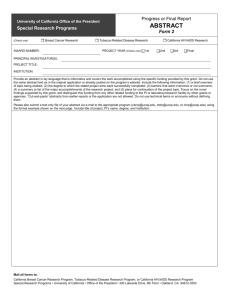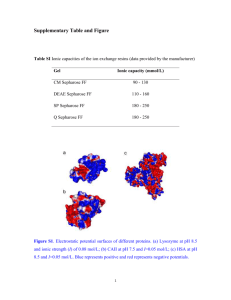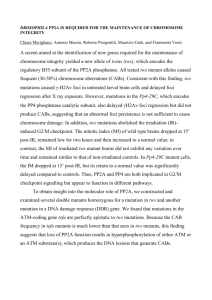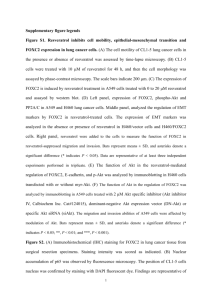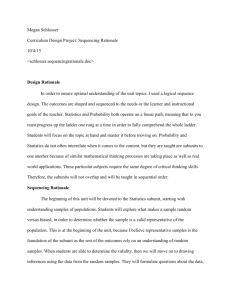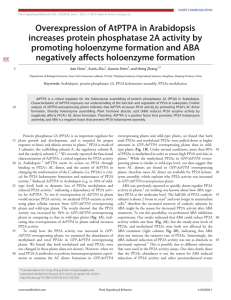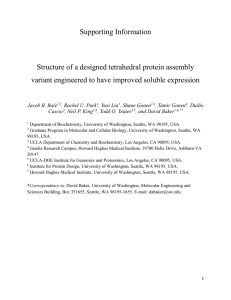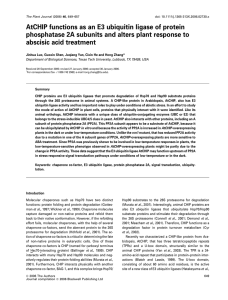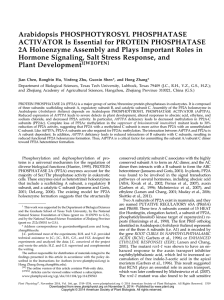Studying the functions of key regulatory genes in plants for... improvement of crop productivity by
advertisement
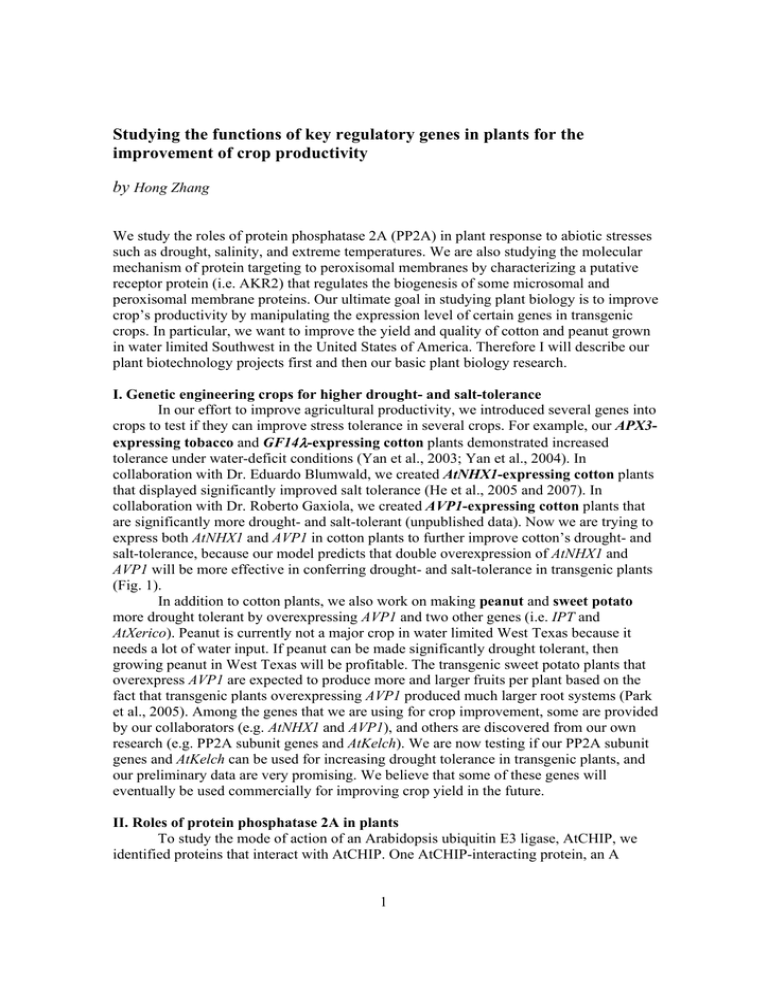
Studying the functions of key regulatory genes in plants for the improvement of crop productivity by Hong Zhang We study the roles of protein phosphatase 2A (PP2A) in plant response to abiotic stresses such as drought, salinity, and extreme temperatures. We are also studying the molecular mechanism of protein targeting to peroxisomal membranes by characterizing a putative receptor protein (i.e. AKR2) that regulates the biogenesis of some microsomal and peroxisomal membrane proteins. Our ultimate goal in studying plant biology is to improve crop’s productivity by manipulating the expression level of certain genes in transgenic crops. In particular, we want to improve the yield and quality of cotton and peanut grown in water limited Southwest in the United States of America. Therefore I will describe our plant biotechnology projects first and then our basic plant biology research. I. Genetic engineering crops for higher drought- and salt-tolerance In our effort to improve agricultural productivity, we introduced several genes into crops to test if they can improve stress tolerance in several crops. For example, our APX3expressing tobacco and GF14λ-expressing cotton plants demonstrated increased tolerance under water-deficit conditions (Yan et al., 2003; Yan et al., 2004). In collaboration with Dr. Eduardo Blumwald, we created AtNHX1-expressing cotton plants that displayed significantly improved salt tolerance (He et al., 2005 and 2007). In collaboration with Dr. Roberto Gaxiola, we created AVP1-expressing cotton plants that are significantly more drought- and salt-tolerant (unpublished data). Now we are trying to express both AtNHX1 and AVP1 in cotton plants to further improve cotton’s drought- and salt-tolerance, because our model predicts that double overexpression of AtNHX1 and AVP1 will be more effective in conferring drought- and salt-tolerance in transgenic plants (Fig. 1). In addition to cotton plants, we also work on making peanut and sweet potato more drought tolerant by overexpressing AVP1 and two other genes (i.e. IPT and AtXerico). Peanut is currently not a major crop in water limited West Texas because it needs a lot of water input. If peanut can be made significantly drought tolerant, then growing peanut in West Texas will be profitable. The transgenic sweet potato plants that overexpress AVP1 are expected to produce more and larger fruits per plant based on the fact that transgenic plants overexpressing AVP1 produced much larger root systems (Park et al., 2005). Among the genes that we are using for crop improvement, some are provided by our collaborators (e.g. AtNHX1 and AVP1), and others are discovered from our own research (e.g. PP2A subunit genes and AtKelch). We are now testing if our PP2A subunit genes and AtKelch can be used for increasing drought tolerance in transgenic plants, and our preliminary data are very promising. We believe that some of these genes will eventually be used commercially for improving crop yield in the future. II. Roles of protein phosphatase 2A in plants To study the mode of action of an Arabidopsis ubiquitin E3 ligase, AtCHIP, we identified proteins that interact with AtCHIP. One AtCHIP-interacting protein, an A 1 subunit of PP2A, is likely a substrate of AtCHIP, because AtCHIP can add one ubiquitin molecule to the A subunits of PP2A in vitro (Luo et al., 2006). AtCHIP appears to function upstream of PP2A in PP2A-mediated signal transduction pathways, because AtCHIPoverexpression activates PP2A activity in vivo and makes plant more sensitive to plant hormone abscisic acid (ABA) treatment (Luo et al., 2006). Overexpression of another AtCHIP-interacting protein, AtKelch, also makes plant more sensitive to ABA treatment, suggesting that AtKelch is also positively involved in ABA signaling pathway. PP2A is a serine/threonine-specific protein phosphatase that plays important roles in eukaryotes, such as regulating DNA replication, gene transcription, and protein translation (Janssens and Goris, 2001). Furthermore, PP2A functions as a tumor suppressor in human (Janssens et al., 2005), which attracts considerable attention in biomedical community. In contrast, much less is known about the functions of PP2A in plants. Literature indicates that plant PP2A plays important roles in hormone signal transduction, temperature stress response, and drought stress response (Delong, 2006). However, the molecular mechanisms of PP2A’s involvement in these processes are not known. PP2A is composed of three subunits: A, B and C subunits. The A scaffolding subunit is responsible for bringing B and C subunits together to form a trimeric holoenzyme. The regulatory B subunit is likely responsible for selecting substrates, regulating enzyme activity, and subcellular localization of the PP2A holoenzyme. The C subunit is the catalytic subunit. There are 3 highly conserved A subunits, 20 variable B subunits, and 5 conserved C subunits in Arabidopsis (Farkas et al., 2007). These subunits could form 300 unique PP2A holoenzymes, which might recognize many different substrate proteins in plant cells. It was recently shown that overexpression of a wheat C subunit gene of PP2A in tobacco increased drought tolerance in transgenic plants (Xu et al., 2007), indicating that PP2A plays an important role in drought resistance. However, a report by Pernas et al. (2007) points to an opposite direction for the role of PP2A in ABA signaling. They analyzed a knockout mutant of the C1 subunit gene of PP2A in Arabidopsis and showed that this mutant is hyper sensitive to ABA treatment. Furthermore, overexpression of this C1 subunit gene confers an ABA insensitive phenotype, which contradicts our data (Luo et al., 2006) and Xu’s data (2007). Since PP2A consists of three subunits: A, B, and C subunits, different combination of these subunits could form different PP2A holoenzymes. The different roles of PP2A in ABA signaling pathway might be mediated by different B subunits. To prove this hypothesis, we are studying the functions of the 20 B subunit genes and the 5 C subunit genes in Arabidopsis, and we plan to analyze the protein-protein interactions of these PP2A subunits (Fig. 2). We believe that by analyzing the functions of the PP2A subunits and the functions of PP2A holoenzymes, we will gain significant insight into the regulatory mechanisms of plant cellular metabolism, which in turn might lead to discoveries for crop improvement. III. Molecular mechanism of protein targeting to peroxisomal membrane The Arabidopsis antioxidant enzyme APX3 (i.e. ascorbate peroxidase 3) is a peroxisomal membrane-bound enzyme. APX3 uses its C-terminal transmembrane domain to anchor into the peroxisomal membrane. We found that a regulatory protein AKR2 (i.e ankyrin repeat-containing protein 2) interacts with APX3, and AKR2 can protect APX3’s activity in vitro and supershift APX3’s activity in a native gel assay system (Yan et al., 2002). AKR2 interacts specifically with APX3 at the peroxisomal membrane targeting 2 signal, mPTS, suggesting a possibility that AKR2 might serve as a molecular chaperone for APX3. This hypothesis is supported by other experiments that proteins with mPTS can also interact with AKR2 specifically. AKR2 may serve as a molecular chaperone for APX3 and other peroxisomal and microsomal membrane-bound proteins (Fig. 3). We are currently using AKR2 mutants to study the relationships between AKR2 and several AKR2interacting and membrane-bound proteins including APX3, CB5 (i.e. cytochrome b5) and CB5R (i.e. cytochrome b5 reductase). In particular, we are studying the localization and stability of these proteins in AKR2 mutants. It is hoped that these studies will reveal a novel mechanism regulating the targeting of certain membrane-bound proteins such as APX3, CB5, and CB5R in plant cells. Literature Cited DeLong, A. (2006). Switching the flip: protein phosphatase roles in signaling pathways. Curr. Opin. Plant Biol. 9, 470-477. Farkas, I., Dombradi, V., Miskei, M., Szabados, L., and Koncz, C. (2007). Arabidopsis PPP family of serine/threonine phosphatases. Trends Plant Sci. 12, 169176. He, C., Yan, J., Shen, G., Fu, L., Holaday, S., Auld, D., Blumwald, E., and Zhang, H. (2005). Expression of an Arabidopsis vacuolar sodium/proton antiporter gene in cotton improves photosynthetic performance under salt conditions and increase fiber yield in the field. Plant Cell Physiol.46, 1848-1854. He, C., Shen, G., Pasapula, V., Luo, J., Venkataramani, S., Qiu, X., Kuppu, S., Kornyeyev, D., Holaday, A.S., Auld, D., Blumwald, E., and Zhang, H. (2007). Ectopic expression of AtNHX1 in cotton (Gossypium Hirsutum) enhances salt tolerance and improves photosynthetic performance. J. Cotton. Sci. 11, 177-185. Janssens, V. and Goris, J. (2001). Protein phosphatase 2A: a highly regulated family of serine/threonine phosphatases implicated in cell growth and signalling. Biochem J. 353, 417. Janssens, V., Goris, J., and Van Hoof, C. (2005). PP2A: the expected tumor suppressor. Curr. Opin. Genet. Dev. 15, 34-41. Luo, J., Yan, J., Shen, G., He, C., and Zhang, H. (2006). Overexpression of AtCHIP, a gene that encodes an E3 ubiquitin ligase, increases protein phosphatase 2A activity and alters plant response to abscisic acid treatment. Plant J. 46, 649-657. Park, S., Li, J., Pittman, J.K., Berkowitz, G.A., Yang, H., Undurraga, S., Morris, J., Hirschi, K.D., and Gaxiola, R.A. (2005). Up-regulation of a H+-PPase as a strategy to engineering drought resistant crop plants. Proc. Natl. Acad. Sci. USA 102, 18830-18835. Pernas, M., Garcia-Casado, G., Rojo, E., Solano, R., and Sanchez-Serrano, J.J. (2007). A protein phosphatase 2A catalytic subunit is a negative regulator of abscisic acid signaling. Plant J. 51, 763-778. Xu, C., Jing, R., Mao, X., Jia, X., and Chang, X. (2007). A Wheat (Triticum aestivum) Protein phosphatase 2A catalytic subunit gene provides enhanced drought tolerance in tobacco. Ann. Bot. 99, 439-450. Yan, J, Wang, J., and Zhang, H. (2002). An ankyrin repeat-containing protein plays a role in both disease resistance and antioxidation metabolism. Plant J. 29, 193-202. Yan, J, Wang, J., Tissue, D., Holaday, S., Allen, R., and Zhang, H. (2003). Protection of photosynthesis and seed production under water-deficit conditions in transgenic tobacco plants that over-express Arabidopsis ascorbate peroxidase. Crop Sci., 43, 1477-1483. Yan, J., He, C., Wang, J., Holaday, A.S. R. Allen, and Zhang, H. (2004). Overexpression of the Arabidopsis 14-3-3 protein GF14λ in cotton delays leaf senescence and improves drought tolerance. Plant Cell Physiol. 45, 1007-1014. (Figures are on the next page) 3 (AtNHX1) 1 H+ Fig. 1. Model on the consequence of simultaneous overexpression of AtNHX1 and AVP1 in transgenic plants. Plant cells are expected to be more salt- and droughttolerant, because of the lower water potential generated inside the vacuole of transgenic plants. 1, Na+/H+ antiporter (e.g. AtNHX1); 2, H+ pump (e.g. AVP1); 3, anion channel; 4, water channel. Na+ Vacuole H+ 3 A– H2O 2 (AVP-1) 4 B1 B2 C1 B3 C2 A1 A2 B4 C3 B5 C4 Salt response ? B6 ..... A3 Drought tolerance ? C5 Low temp response? B20 Fig. 2. Potential protein-protein interactions among PP2A subunits in Arabidopsis and their potential specific functions as holoenzymes. Fig. 3. A model on how AKR2 might serve as a molecular chaperone for APX3 before APX3 is targeted to peroxisomal membrane. 4
